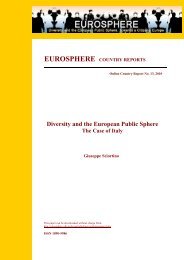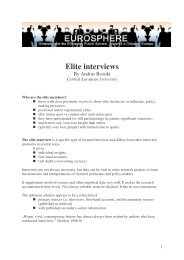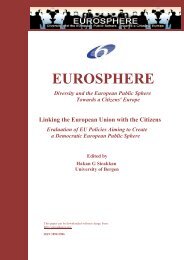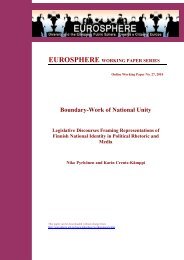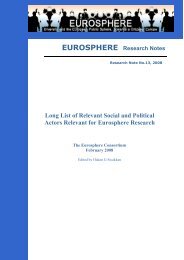Migrants, Minorities, Belongings and Citizenship. Glocalization and ...
Migrants, Minorities, Belongings and Citizenship. Glocalization and ...
Migrants, Minorities, Belongings and Citizenship. Glocalization and ...
You also want an ePaper? Increase the reach of your titles
YUMPU automatically turns print PDFs into web optimized ePapers that Google loves.
Figure 11. (Mis)alignments in National/Essentialized vs. Glocal Spaces by Category<br />
Figure 11 shows that majority citizens, imperial new minorities, second <strong>and</strong> third country<br />
nationals, <strong>and</strong> extra-territorials are the most content with how glocal spaces articulate<br />
<strong>and</strong> promote their preferences. At the same time, they are discontent with the national<br />
<strong>and</strong> essentialized public spaces. On the other h<strong>and</strong>, those who are most content with the<br />
combined impact of national <strong>and</strong> essentialized spaces are historical native minority<br />
members <strong>and</strong> historical imperial historical minority members.<br />
2.3. Explaining (mis)alignments in public spaces: three models<br />
Based on this projects’ theoretical point of departure, the misalignments between<br />
respondents’ preferences <strong>and</strong> the available public spaces’ capability to be responsive can<br />
be related to respondents’ mobility patterns (both spatial <strong>and</strong> mental), participation<br />
patterns, <strong>and</strong> belonging patterns as well as the features of the public spaces.<br />
The respondents reported that they attend to one or several of four types of public<br />
spaces: national (numeric <strong>and</strong> corporate), essentialized (ethnic <strong>and</strong>/or religious<br />
organizations), <strong>and</strong> glocal spaces. All the respondents – except those residing in Estonia<br />
– were contacted while <strong>and</strong>/or because they were visiting a glocal space. In this analysis,<br />
assuming that the types <strong>and</strong> degrees of (mis)alignments are due to the respondents’<br />
90



